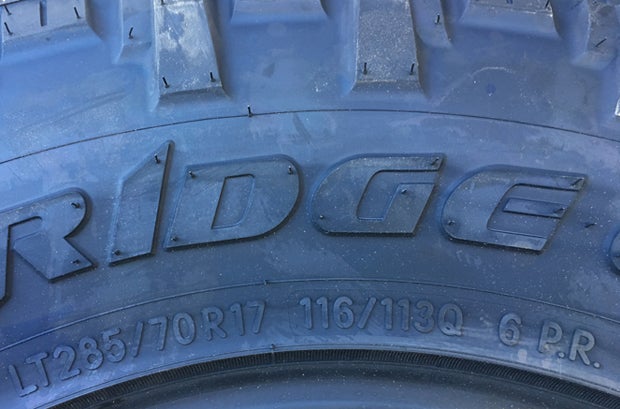
Tire sizes may look like an impenetrable code, but they’re actually easy to read once you understand what every letter and number means. Here’s a quick guide to understanding how to read the tire size specifications on the sidewall.
Using this example of a slightly oversized tire that many off-roaders might use (roughly a 33”) on their truck or SUV, let’s break down the information on our LT285/70R17 Nitto Ridge Grappler tire.
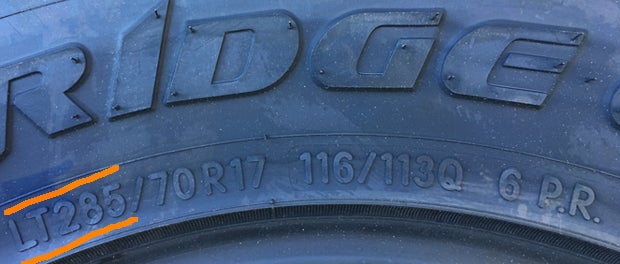
The “LT” is simple – it stands for light truck tire, which refers to both trucks and SUVs built on a truck-like chassis. On passenger cars, a “P” will be in place of “LT” and that stands for passenger tire. A European tire will have no letter.
The “285” on our LT tire stands for section width or tread width, which, simply put, is the distance from sidewall to sidewall, measured in millimeters. So our LT tire section width of 285 millimeters, which equates to a width of tread of 11.22 inches. 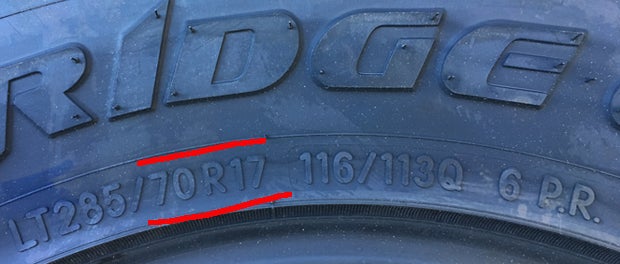
Next up after the / is perhaps the trickiest one – aspect ratio. This is the ratio of sidewall height to width. So the “70” here stands for percent. In this case, the sidewall is 70% of the 285-millimeter width, or 199.5 millimeters (or 7.85 inches). To calculate the overall tire size, we take the 7.85 and multiply it by two and then add the wheel size (17 inches in this case) and you'll have the proper size of 32.7 inches.
The next letter after the aspect ratio is “R” which stands for radial construction, and it’s more or less redundant since almost every car or truck on the road uses radial construction for its tires. Bias-ply tires are mostly relegated to the past and are typically used on classic cars and trucks.
The number “17” stands for the diameter of the wheel the tire is mounted on. This is measured in inches.
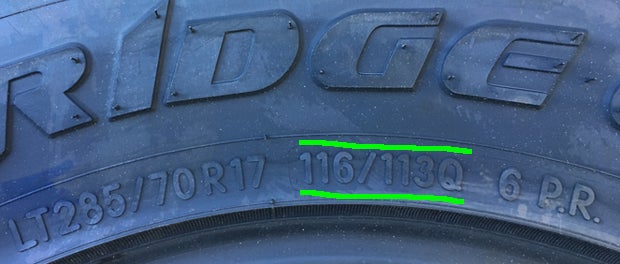
The next number 116/113 is for the maximum load carrying capacity of the tire, or the “Load Index.” The first number relates to the maximum load capacity on a traditional truck (which one wheel on each end of the axle), while the second number refers to a dual wheel use on each end of the axle, or specifically for dually-style struck that run four tires on the rear axle. The 116 number means the single tire has a load index of 2,756 lbs. When you combine that figure with the other tire on the rear axle you reach the vehicle’s proper load carrying capacity on that axle (5,512 lbs.). Only install tires that meet or exceed what’s listed in the vehicle’s owner’s manual.
The last letter “Q” that follows the Load Index denotes the actual mph that it’s safe to drive on with the tire, assuming it’s installed correctly and inflated properly. The type of use is also factored into this equation, as truck tires have to factor in load capacity and the additional air it will carry, which in turn makes it harder to cool down and therefore it will not have as high a rating as passenger vehicle might in spite of the tire's sturdy construction. The Q rating, in this case, stands for 100 mph, though of course drivers should not take this as a license to exceed the posted speed limit (just to be clear).

Light truck tires also have another rating for what’s called Load Range, and as you can see in the photo above on our example tire the Load Range is listed separately from the rest of the tire specs –Load Range C. Sometimes, that rating will be listed like this instead LT265/65R18C, with the C Load Range listed at the end of the tire specifications. This number is based on a measurement called ply ratings, in which the more plies a tire has the more pressure it can hold and weight it can withstand for towing and hauling purposes. Off-road enthusiasts may be familiar with the concept of plies in relation to sidewall construction, because traditional the more plies the tire has the tougher it will be and less prone to tearing on rocks and debris while off-road.
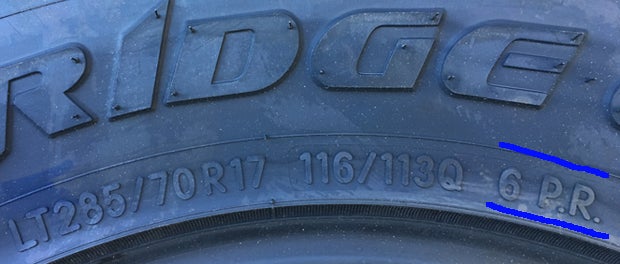
In reality, most modern C Load Range tires (or any load range for that matter) aren’t actually built with six rubber-and-cord plies; instead, they are built with two or three stronger plies with a strength equivalent to six plies. If you look at the final number on our tire it says “6 P.R.” which means it has a 6-ply rating.
There are other key numbers that don’t relate to size – among the Department of Transportation number each tire gets to show it meets minimum standards for sale, and the maximum inflation pressure. Note that maximum is not the ideal – the ideal inflation number is usually listed in the door jamb and owner’s manual. The proper inflation number also can very depending upon if you’re towing a trailer or are not. Inflation is measure in pounds per square inch.
MORE OFF-ROAD.COM STORIES
How To Get into Overlanding
Impression: AEV 20th Anniversary Edition Ram 2500 Prospector XL


 Your Privacy Choices
Your Privacy Choices